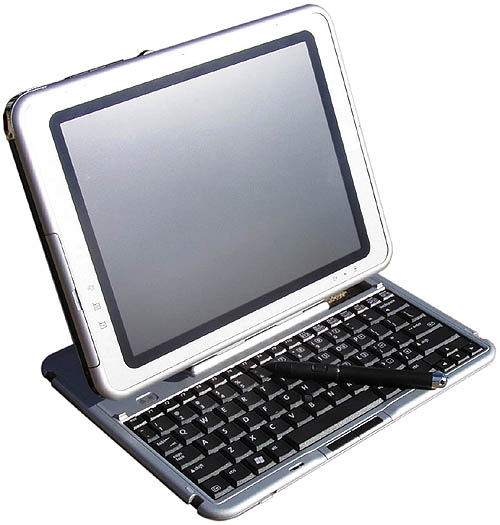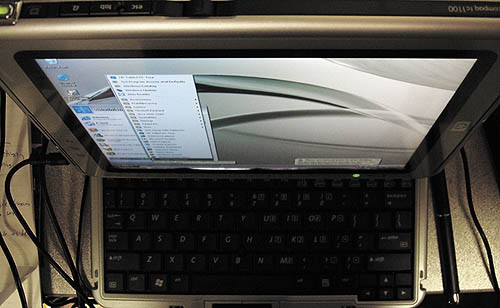

Current Cover
Recent issues






|
|
|
|
|
|
PenLab: Hewlett Packard TC1100Subtle improvements that pack a major punch (May 2004 issue)The Compaq Tablet PC was conceived when Compaq was still Compaq and not part of Hewlett Packard. Compaq, of course, had considerable experience in pen systems, in part from the development of the Concerto pen computer of the mid 1990s and in part from its great success with Pocket PCs. The original prototype of the Compaq Tablet PC, in fact, looked like a giant iPAQ Pocket PC. It was nothing but an insider joke, one that Compaq's Tablet PC product manager freely shared with us press types, but it sure got everyone's attention.
In the end, the final Compaq Tablet PC design looked nothing like an iPAQ but a whole bunch like a modern reincarnation of the brilliant Concerto. Good DNA is hard to suppress. Compared to most of the competition, Compaq, however, took some chances. For example, while the original Microsoft Tablet PC specification suggested a low-power Transmeta processor, by the time actual Tablet PC hardware was ready to roll, almost everyone had abandoned the Crusoe in favor of Intel Pentium processors. Almost everyone, but not Compaq which chose a 1GHz Crusoe TM5800 for the initial TC1000 Tablet PC. But that wasn't the only area where Compaq deviated from the pack. They were also the only ones that selected the FinePoint digitizer over Wacom's technology. Both choices had their technological merits, but both went against the flow. Finally, the TC1000 looked dramatically different from any other Tablet PC. It was neither a pure slate nor a notebook convertible but, like the Concerto, something inbetween. It had a snap-on keyboard that was more tightly integrated into the Compaq's design than any of the garden-variety dual-purpose keyboards that also serve as a display cover. Some people loved it. Others felt it was a bit cumbersome in real life use.
Enter the TC1100A year later Compaq, now part of HP, released the first major update to its Tablet PC product. It's called the TC1100 and you'd never know it was almost all-new just from looking at it. Put the original TC1000 and the new TC1100 side by side and they appear, for all practical purposes, to be identical. But in this case appearance is quite deceptive. The TC1100 is, in fact, a fundamental redesign. It looks almost the same, but all the major underpinnings have been changed. Gone is the Transmeta processor. It's been replaced by standard Intel fare, either a 800 MHz Celeron or an ultra low voltage 1GHz Pentium M processor. Gone, too, is the FinePoint digitizer. It has been replaced with ubiquitous Wacom technology. You'd never know unless you checked the specs or were a fan of Finepoint's technology which some still consider superior. That's because the pen of the TC1100 looks exactly like the old Finepoint pen did--thicker than the slender Wacom pen which does not need its own battery. Finally, and perhaps most importantly, Hewlett Packard was smart enough to snag the sensational BOE Hydis display for the TC1100. What's so special about it? That would be the extremely wide viewing angle in both directions. A full160 degrees both ways as opposed to just 100 degrees vertical as is usually the case with standard LCDs. You can look at this display from every angle and the picture never changes. That is extremely important in a Tablet PC that will be used both in portrait and in landscape mode. You won't believe the difference between this display and a standard LCD until you see it.
With all this different technology under the hood, some other specs have changed as well. The video controller is now NVIDIA GeForce4 class rather than GeForce2, with twice the video RAM. There is faster DDR RAM and you can pack up to 2GB into a TC1100 as opposed to just 768MB in the original. Wireless LAN is standard. There is IrDA and Bluetooth and a SD Card slot (instead of the CF card slot of the original). Nothing special here, just routine updates to the current state of the art. The battery remains the same, as does your choice of a 30, 40, or 60 GB disk. There is still no Firewire port, something that wasn't missed much on the original machine with its relatively modest performance, but something that could be missed on a faster machine with better graphics. The overall design of the TC1100 remains completely unchanged. There's still that ingenious snap-on keyboard that's a mixed bag of goods in several respects. It is beautifully integrated and provides a very stable basis for the whole keyboard/system unit assembly, but when you tap the display with the pen, the LCD flexes just as much as it does on notebook convertibles with a swivel hinge. The keyboard keys feel solid, provide very good tactile feedback, and there is a ThinkPad-style touch pointer on the keyboard. But the large numerical keypad labels makes for a somewhat cluttered look, and even though the keyboard is wide enough for a full 100%-scale QWERTY implementation, those most important keys remain at 95%-scale. This is too bad as it is possible to put a full QWERTY implementation even on a compact keyboard by making punctuation keys slightly narrower (see review of Getac W130 on page 24). Everyday useHow does the new model feel in everyday use compared to its (still available) predecessor? The difference is like night and day. All the laudable merits of the Transmeta processor architecture notwithstanding, the Pentium-based TC1100 is much faster in every respect. Gone are the long waits and the somewhat inconsistent performance of the TC1000. Same for the tremendous difference between the original's display and the TC1100's wide viewing angle display. I cannot over-emphasize what a huge difference that makes. Other than that, HP's Tablet PC remains a design that evokes mixed emotions. Almost everyone agrees that it looks great, but opinions on the snap-on/swivel keyboard vary. Once you figure out which snaps and latches to push and pull, and how to twist and turn the thing into position it works well enough, but I actually preferred the old Concerto solution where the system unit has a detachable keyboard and a handle as an adjustable stand. Still, the overall impression remains entirely positive.I really like some of the small changes HP made. While not too many people use IR these days, I appreciate its presence because I like to synchronize my Pocket PCs via IR. And replacing the Compact Flash slot with a SD slot makes sense also. You can always stick a CF adapter into the PC Card slot if you must use a CF card. Me, I like carry around a SD card that I can use in my digital camera, my Pocket PC, and the TC1100. Good stuff has a priceHow about pricing? Here's the situation: The original TC1000 is still available at US$1,699. The TC1100 starts at US$1,849. However, that's for the Celeron version that does not have the wide viewing angle display, less RAM, and a smaller disk than the Pentium M-based model. That one goes for US$2,299. For the extra money you get the faster processor, the wide viewing angle display, 512MB of RAM, a 40 instead of a 30GB disk, and a three year warranty instead of just one. US$450 more is quite a bit of money and puts the TC1100 right up there into the premium price category, but if you can afford it, the wide angle display alone is worth the extra bucks.HP also offers a myriad options and accessories for its Tablet PCs. There are various carrying cases, wireless options, caddies, docking station options, and a number of bundles. The HP website lets you build your own customized Tablet PC, just like all the major PC manufacturers allow you to spec out a desktop PC.
To use an automotive analogy, the TC1100 sort of remains the Citroen of Tablet PCs--hugely innovative and ahead of its time in many respects, but also a bit odd and quirky even though the Intel processor, Wacom digitizer bring it closer to the norm. -
HP: www.hp.com
-
|



